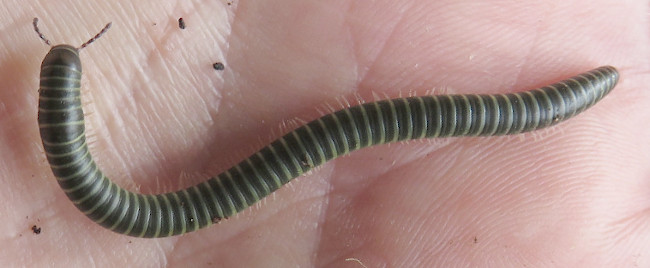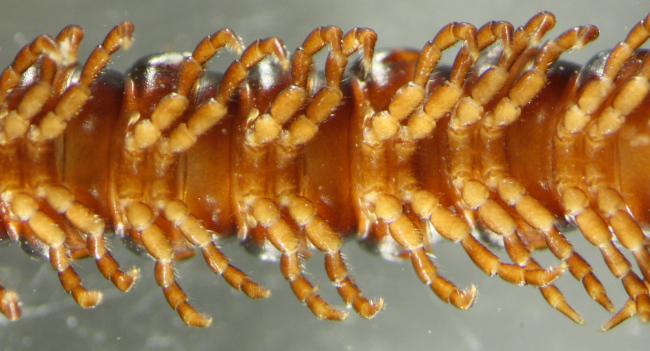Introduction
There are about 220 species of native and introduced millipedes in Tasmania. This website will help you identify most of them, and will also tell you a little about their distribution and habits.
This is not a resource for taxonomists. If you are interested in the taxonomic details of particular genera and species, please visit MilliBase. You can also download the archived website Millipedes of Australia, which was "frozen" in 2019 (no longer updated).

Amastigogonus fossuliger (Spirostreptida: Iulomorphidae)
About millipedes
Most Tasmanians can recognise millipedes on sight, and the introduced species are often called "curly worms". Millipedes are long and thin with many legs. Millipedes are sometimes confused with centipedes, which have one pair of legs on each body segment and occasionally bite people. Millipedes are harmless and have two pairs of legs on most body segments.

Somethus tasmani (Polydesmida: Paradoxosomatidae)
Ventral view of midbody, showing 2 pairs of legs on each body segment.
In Tasmania, adult millipedes of different species range from 2 mm long to ca 90 mm. They can be found in every terrestrial habitat, from coastal sand dunes to rocky mountaintops, and from moorland to rainforest. The native species feed on fungi and rotting vegetation.

The largest millipedes in Tasmania live in the dry forests of the East Coast.
Pictured is a male of Amastigogonus orientalis from Orford.
Tasmania's milipedes probably live for 2-3 years, egg to adult (the larger Spirostreptida may live longer). Male and female adults can be found at most times of the year. Millipedes normally hide in the soil, in forest floor litter or in rotting logs. You may not see millipedes as you wander in the bush, but they're always present. A single patch of forest in Tasmania can be home to 15-20 millipede species.
So far as I know, no native Tasmanian millipede species is threatened with extinction. Some species have a very small geographical range, but are quite abundant within that range.
The most important threatening process for millipede populations is clearing of native vegetation for agriculture. In parts of Tasmania that have been farmed or grazed for many years, invasive millipede species have almost completely displaced the natives. Field studies have shown that native millipede populations recover well after forestry operations, including conversion to plantation (see References). Native millipedes can occasionally be found in suburban gardens close to the bush.
Two cautions
The identification keys on this website are designed for the Tasmanian fauna. They should not be used for non-Tasmanian millipedes. Most of Tasmania's native millipedes are endemic to Tasmania. This means that even if you find a millipede somewhere else in the world which looks almost exactly like one of the endemic Tasmanians on this website, it is highly unlikely that they are the same animal.
For most identifications you will need a low-power microscope or a strong hand-lens. Once you get to know the Tasmanian millipede fauna, you will be able to identify some species with your unaided eyes, but even experts need magnification for positive identifications. For all but a few species, you cannot identify a millipede from an image of the whole animal. Millipedes are very poor subjects for image-based identifications on iNaturalist, QuestaGame and Facebook nature groups.

Gasterogramma austrinum (Polydesmida: Dalodesmidae)
Image by Reiner Richter
About the maps
The distribution maps on this website are built from an occurrences file I maintain with 10000+ records for preserved specimens deposited in museums. The file is Darwin Core-compliant, corrects errors found in Atlas of Living Australia records and is frequently updated. A slightly out-of-date version is available here and through GBIF.
Updates and licensing
This website is a revised, updated and re-formatted version of the millipede parts of another website, Tasmanian Multipedes, which went online in 2003. The site was "frozen" in 2013 and later taken offline, but is still available for download in the Zenodo data repository. The earlier website also has information about Tasmania's centipedes, velvet worms, Symphyla and Pauropoda.
The text and uncredited images on this website are my own work and are copyright under a Creative Commons Attribution-NonCommercial 4.0 International License. You are welcome to use or copy the information and uncredited images on this website for non-commercial purposes, but please attribute what you use to this source.
The July 2025 version of this website has been archived in Zenodo and can be downloaded as a 17 MB ZIP file for local use.
For further information about the Tasmanian Millipedes website, please email me directly. Please note that I have partly retired from scientific work and may not be able to help with millipede identifications.
Robert Mesibov
West Ulverstone, Tasmania
ORCID
CV and publications
Updated 4 November 2025
